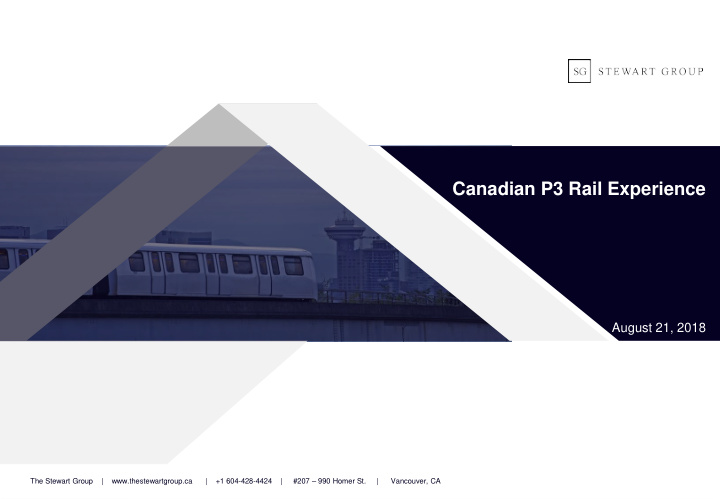



Canadian P3 Rail Experience August 21, 2018 The Stewart Group | www.thestewartgroup.ca | +1 604-428-4424 | #207 – 990 Homer St. | Vancouver, CA 1
Canadian Transit Market Overview 2 2
Vancouver’s Canada Line • Project Background • Structure • Performance • Lessons Learned 3 3
Project Background • Canada’s first & largest P3 partnership • 19 km with 16 stations, Automated • Opened 2009 • Separate line • Separate O&M • 35-year concession agreement 4 4
Project Background 5 5
Structure - Contractual 6 6
Structure - Funding 7 7
Performance - Ridership • Day 1 – 82K passengers • Year 1 - 36.2M passengers • 3.8M passengers during Winter Olympics • System availability – 99.9% • Station availability – 99.9% Source - TransLink ---- Actual Ridership ---- 2005 Ridership Forecast 8 8
Performance - Customer Satisfaction Source - TransLink 9 9
Lessons Learned – Owner’s View • Accept a certain amount of loss of control • Risk transfer – retain those that are important to your organization • Distance project decisions from politics • There will be disputes – ensure resolution process is clear and acceptable • Difficult to manage and implement • Anticipate growth and changes, clarify in PA 10 10
Lessons Learned – Proponent’s View • Performance based; not overly prescriptive • Reasonable honorarium • Limit the amount of change (freeze scope) • Risk costs money - concessionaire will always price risks that are transferred to them • Reasonable handback standards • Tight budget and schedule made it a good candidate for P3 • Knowledgeable owner’s team acting for all gov’t stakeholders 11 11
P3 Projects in Development 12 12 12
Edmonton Valley Line 13 13
Project Background • 27 km “urban-style” LRT • Largest transit investment in City’s history - >$4B • Developed in two phases 14 14
Project Background • Phase 1 - $1.8B • Pre-procurement and procurement phase 2012-2016 • 13 km • 12 stations/stops • At-grade, elevated and tunnelled • Bridge crossing • New technology - low floor, surface rail • Separate but integrated 15 15
Structure • Edmonton’s first P3 rail project • Contract awarded – Feb 2016 • DBFOM + V • 30-year O&M term • VfM achieved – 24% 16 16
Performance • 2.5 years into construction • Schedule and financial pressures • City monitoring Project Co closely 17 17
Phase Two - Challenges of Expansion • 14 km extension, connecting in Downtown Core • $2.2B - $2.4B estimate • Early availability of funding accelerated project timeline • P3 contract schedule on expansion provided limited guidance on expansion protocols • Owner faced with possible sole source for scope elements vital for system interoperability 18 18
Considerations • Re-negotiating a 30-year O&M contract is challenging • Agreements not designed for flexibility • Lender’s issues • Interface and integration risk • Customer experience (transfer point) • Performance to date • Maintaining VfM achieved in Phase One • Untested O&M performance 19 19
Ottawa Confederation Line 20 20
Project Background 4 th largest metropolitan hub in Canada • • $2.1B LRT system • 12.5 km with 13 stations/stops • At-grade, elevated & 2.5 km tunnel 21 21
Structure • Ottawa’s first P3 rail project • Contract awarded - Dec 2012 • DBFM + V • 30-year maintenance term • Operated by municipality 22 22
Performance • Construction launch – Winter 2013 • Original revenue service date - Spring 2018 • Revised revenue service date - Fall 2018 • Sink hole challenges 23 23
Challenges of Expansion • Package of three rail extensions • Contract didn’t contemplate extension of this magnitude 24 24
Approach • Required sole source and competitive tender • Owner purchased additional vehicles, maintenance, systems and expansion to OMF ~ $500M • Project Co also given CM role to maintain quality regime • Competitive tender for remaining scope • Interface agreements required • Systems integration an evolving challenge • Satisfying lenders costly - long-term debt buy-out required 25 25
Surrey-Newton-Guildford LRT 26 26
Project Background • Two phase LRT project in Vancouver suburb • Phase One – 10.5 km of surface rail; fully funded • Phase Two – 16.5 km (technology still under review) • Phase Two not funded 27 27
Approach for Phase One • DBFOM • Shorter O&M term – 7 years • Rationale • Start up and early Ops risk transferred to private sector • Shorter term gives owner more flexibility on expansion & avoids expensive termination payments 28 28
Conclusions • Contemplate future expansion; plan for it in the PA • Understand termination costs at project outset • Examine possibilities of pre-pricing certain key expansion elements/ both civil and debt • Lenders are a big deal • Change is inevitable in a transit system • Current P3 model not designed to be flexible 29 29 29
Lecia Stewart Lecia@thestewartgroup.ca 604-764-8424 Source: xxx 30 30
Recommend
More recommend